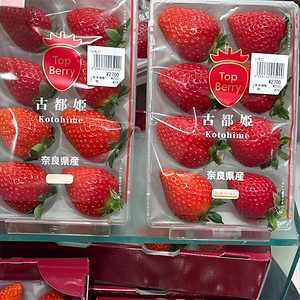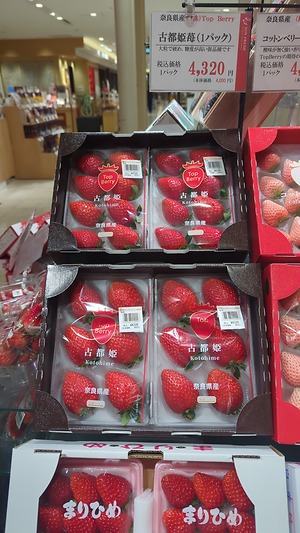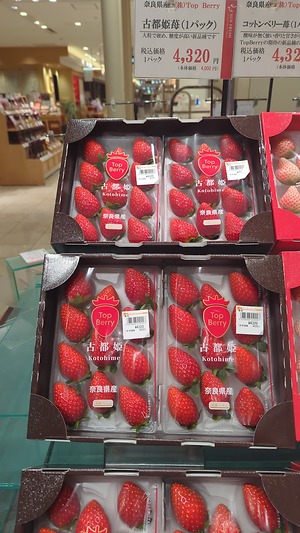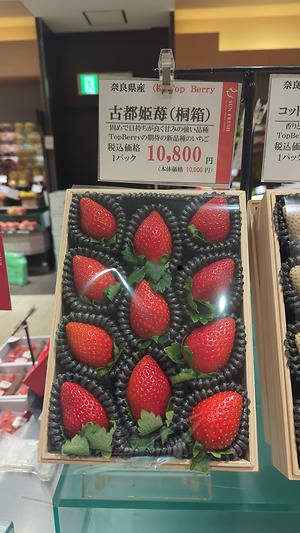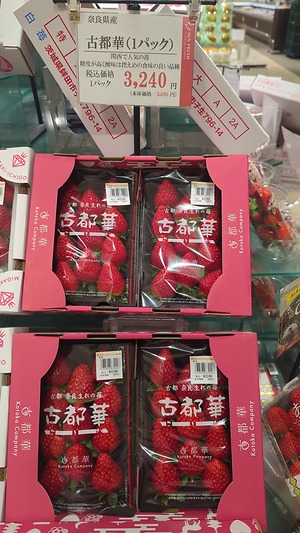

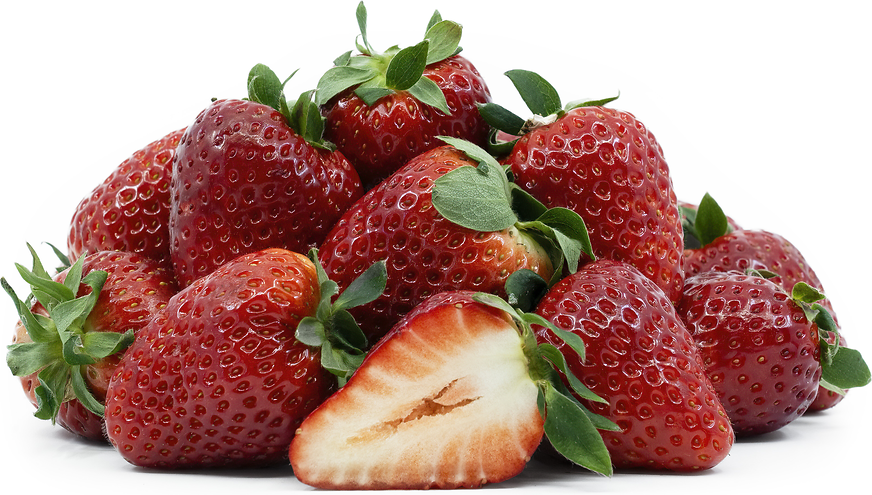
Kotoka Strawberries
Estimated Inventory, lb : 0
Description/Taste
Kotoka strawberries vary in size, depending on growing conditions, and average 2 to 3 centimeters in diameter and 4 to 6 centimeters in length. The variety has a uniform, conical appearance with sloping shoulders tapering to a blunt or pointed, curved tip and is topped with a fresh, green leaf cap. The fruit’s surface is glossy, delicate, and taut, with a smooth, lightly pebbled feel created from the indentation of tiny yellow-red seeds. The skin is easily bruised if handled roughly and ripens to vibrant shades of ruby red. Underneath the surface, the pale red to light pink flesh is firm, aqueous, and tender with a succulent, pleasantly chewy consistency. The center of the fruit can also be solid to slightly hollow. Kotoka strawberries release a robust, sweet, and fruity aroma. The strawberries are edible raw when ripe and are known for their high sugar content, ranging from 12 to 15 degrees Brix, mixed with high acidity. This balanced blend of sugar and acidity creates a rich, sweet, and tangy, fruity, and candy-like taste.
Seasons/Availability
Kotoka strawberries are available in the winter through late spring, with a peak season from January through March.
Current Facts
Kotoka strawberries, botanically classified as Fragaria ananassa, are a Japanese variety belonging to the Rosaceae family. The variety was developed in the late 20th century as a new commercial cultivar and was officially released in the early 21st century as a specialty fruit of the Nara Prefecture. Kotoka strawberries are exclusively grown in the Nara Prefecture and are positioned as a premium variety available in limited quantities. The variety is challenging to grow as it is susceptible to diseases and only blooms in small numbers. The fruits must also be picked at peak ripeness without damaging the delicate flesh for the best quality, flavor, and eating experience. Kotoka strawberries, also known as Kotouka, are often compared to the luster and vibrancy of rare jewels and are prized for their balanced sweet-tart taste, uniform nature, and juicy consistency. One of the unique characteristics of Kotoka strawberries is their ability to maintain a uniform flavor throughout the season. The fruits are said to taste the same, a trait that fluctuates in other strawberries, depending on weather and growing conditions, and the flesh is also reported to have a uniform flavor from the tip of the fruit to the shoulders. Kotoka strawberries have a longer shelf life than other commercial cultivars, but the variety does not typically appear in large quantities in commercial markets. Kotoka strawberries are offered in small amounts, often online through vendors, each year and are an anticipated seasonal delicacy.
Nutritional Value
Kotoka strawberries have not been extensively studied for their nutritional properties. Like other commercial Japanese strawberries, the variety may be a source of fiber to regulate the digestive tract, potassium to balance fluid levels, vitamin E to protect the cells against the damage caused by free radicals, and vitamin C to strengthen the immune system. Kotoka strawberries may also provide vitamin A to maintain healthy organs, vitamin K for faster wound healing, calcium to build bones and teeth, magnesium to control nerve functions, and other nutrients, including iron, copper, phosphorus, and manganese.
Applications
Kotoka strawberries have a balanced, sweet, and tangy taste suited for fresh or cooked preparations. The variety is traditionally eaten out of hand and is enjoyed raw to appreciate its flavor and texture. Kotoka strawberries are often given as gifts to family, friends, and coworkers during celebrations and are considered a rare delicacy. The fruits are washed and eaten as a snack or dessert or dipped in cream, chocolate, or hazelnut spreads as a decadent treat. Kotoka strawberries can also be sliced to decorate tarts, cakes, parfaits, and other desserts or layered into sandwiches filled with whipped cream. While less common, the variety can be incorporated into any recipe calling for strawberries. The fruits can be tossed into salads and fruit medleys, blended into smoothies or shakes, or used to flavor scones, shortcakes, crumbles, and muffins. In Japan, Kotoka strawberries are infused into a refreshing seasonal cider. They are also simmered into syrups, jams, jellies, and sauces. Kotoka strawberries pair well with vanilla, chocolate, maple syrup, condensed milk, whipped cream, and nuts such as almonds, hazelnuts, pecans, and walnuts. Whole, unwashed Kotoka strawberries have a slightly firmer flesh than other commercial Japanese varieties, allowing them to be kept for a few days in a plastic bag in the refrigerator. The fruits should be washed just before eating, and it is recommended to be consumed quickly after purchase for the best quality and flavor.
Ethnic/Cultural Info
Kotoka strawberries acquired their name from a public contest in Japan. The name Kotoka is derived from “koto,” a descriptor for the “Heijo capital,” and “ka,” meaning “flower.” When combined, the name roughly translates to “a new flower blooming in an ancient capital.” This name was selected as the Hejio capital, which was once the capital of Japan during the Nara Period, from 710 to 740 CE. Kotoka strawberries were given their name in 2010, commemorating the 1300th anniversary of the relocation of Japan’s capital to Nara. Strawberry growers in the prefecture hope the modern variety will help strengthen the Prefecture’s presence and reputation in strawberry cultivation, and the fruits are protected under breeding rights to only be grown in Nara for several years. In addition to its exclusivity and hope for the prefecture, Kotoka strawberries are marketed through specialty desserts across the prefecture. At a roadside station called Yamatoji Heguri Restaurant Hanana in the town of Heguri in the Ikoma District of the Nara Prefecture, Kotoka strawberries are famously used in a large parfait. Heguri is known for being one of the top strawberry-producing regions in the prefecture. The strawberry parfait reaches over thirty centimeters in height and features over twenty Kotoka fruits. It is a seasonal dish that attracts visitors worldwide and is available through reservations only from mid-January through early April each year.
Geography/History
Kotoka strawberries are native to Japan and are exclusively grown in the Nara Prefecture in Central Japan. The variety was developed by the Nara Prefectural Agricultural Center, now known as the Nara National Agricultural Center, beginning in 1988. It was created from a cross between Beni Hoppe strawberries, the pollen parent, and 7-3-1 strawberries in 1989. After the initial cross was made, over 3,000 potential seedlings were grown to select the plant with the most favorable characteristics. Evaluations and selections continued for many years until one seedling was chosen for commercial release in 2009. The new variety was initially called Nara No. 8 but was later changed to Kotoka in 2010. Kotoka strawberries were submitted for registration in 2009 and were recognized and registered as a new variety by the Japanese government in 2011. Since its release, Kotoka strawberries have steadily increased in popularity and are positioned to take over the most produced variety in the Nara Prefecture, replacing Asuka Ruby. Kotoka strawberries are exclusively grown in the Nara Prefecture and are protected under breeding rights. The variety is grown by a few farms in the prefecture and is primarily cultivated in Heguri, where the fruits were first developed. Heguri is located in the northwestern region of the Nara Prefecture and is known for having warm days and cool nights, a trait known for helping strawberry crops produce their signature candy-like sweetness. Kotoka strawberries are cultivated in greenhouses and are harvested as a specialty fruit for sale in select high-end stores and online shops throughout Japan. The variety is also offered directly through growers when in season.



